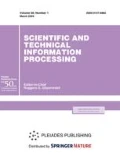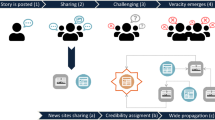Abstract—
In this article, series of questions related to the conceptual basis for studying the characteristics of the emergence and evolution of the “fake news” phenomenon are proposed. An analysis is made of the transformation of information strategies and political communications in a digital society and the relationship of fake news with interpretations of social traumatic events are fixed.
Similar content being viewed by others
Notes
Mediatization can be understood as modifying (distorting) the facts of reality and giving them mediated meanings that arise during fabrication of imaginary images in the process of collecting, processing (filtering) and transmitting information data [20, p. 84].
A way to build a framework of communication, characterized by an underlined decorative effect and features of a mass entertainment illusion. The term was introduced by B.A. Ouspensky [25, p. 206].
REFERENCES
Gilyarevskii, R.S., Informatsionnaya sfera: Krat. entsikloped. slov. (Information Sphere: Brief Encyclopedic Dictionary), St. Petersburg: Professiya, 2016.
Amarasingam, A., The Stewart/Colbert Effect: Essays on the Real Impacts of Fake News, Jefferson, North Carolina–London: McFarland & Company, Inc., Publishers, 2011.
Hunt, A. and Gentzkow, M., Social media and fake news in the 2016 election, J. Econ. Perspect., 2017, no. 31, pp. 211–236.
The science of fake news. Addressing fake news requires a multidisciplinary effort, Science, 2018, vol. 359, pp. 1094–1096.
Issers, O.S., Media fakes: Between truth and mystification, Kommun. Issled., 2014, no. 2, pp. 112–123.
Sukhodolov, A.P. and Bychkova, A.M., Fake news as a phenomenon of modern media space: The concept, types, purpose, and countermeasures, Vopr. Teor. Prakt. Zh., 2017, vol. 6, no. 2, pp. 143–169.
Dubrovskii, D.I., Obman. Filosofsko-psikhologicheskii analiz (Deception. Philosophical and Psychological Analysis), Moscow: Kanon + ROOI Reabilitatsiya, 2010.
"Politika postpravdy" i populizm (Post-Truth Policy and Populism), Popova, O.V., Ed., St. Petersburg: Skifiya-print, 2018.
Byelonogov, G.G. and Gilyarevskii, R.S., Another treatise on the epistomological status of the concept of “information,” Autom. Doc. Math. Linguist., 2010, vol. 44, no. 1, pp. 38–43.
Merton, R., Self-Fulfilling Prophecy (Thomas’s Theorem). http://socioline.ru/pages/r-mertonsamoispolnyayuscheesya-prorochestvo-teorema-tomasa. Accessed February 8, 2019.
Kastel’s, M., Vlast’ kommunikatsii (The Power of Communication), Moscow: Dom Vyssh. Shk. Ekon., 2016.
Rudenkin, D. and Loginov, A., Ideology in the society of the late modernity: Disappearance or transformation, Sotsiol. Obozr., 2018, no. 3, pp. 197–220.
Miletskii, V.P. and Pimenov, N.P., Politiko-sotsiologicheskoe izmerenie sotsiodinamiki politicheskikh kommunikatsii v sovremennoi Rossii (The Political and Sociological Dimension of the Sociodynamics of Political Communications in Modern Russia), St. Petersburg: SPbGETU LETI, 2017.
Lazarsfeld, P.F., Berelson, B., and Gaudet, H., The People’s Choice: How the Voter Makes up His Mind in a Presidential Campaign, New York: Columbia University Press, 1948.
Festinger, L., A Theory of Cognitive Dissonance, Stanford, CA: Stanford University Press, 1957.
Katz, E., Blumler, J.G., and Gurevitch, M., Utilization of mass communication by the individual, in The Uses of Mass Communications: Current Perspectives on Gratifications Research, Beverly Hills, CA: Sage, 1974, pp. 19–32.
Gerbner, G., Mass media and human communication theory, in Human Communication Theory, New York: Holt, Rinehart and Winston, 1967, pp. 40–60.
Gerbner, G., Toward a general model of communication, Audio-Visual Commun. Rev., 1956, vol. 4, pp. 171–199.
Shaw, D.L. and McCombs, M.E., The Emergence of American Political Issues: The Agenda-Setting Function of the Press, St. Paul, MN: West, 1977.
Zemlyanova, L.M., Mediatization of culture and comparativism in modern communicationism, Vestn. Mosk. Univ., Ser. 10, Zh., 2002, no. 5, pp. 83–97.
Hjarvard, S., The mediatization of society: A theory of the media as agents of social and cultural change, Nordicom Rev., 2008, vol. 29, no. 2, pp. 105–134.
Zhizhek, S., Cyberspace, or the unbearable closure of being, Iskusst. Kino, 1998, no. 1, pp. 125–137.
Voinova, E., Mediatized political communication: A way of media policy distortion or a way to organize discourse?, Vestn. Mosk. Univ., Ser. 10, Zh., 2006, no. 6, pp. 6–10.
Modern trends in the development of the symbolic space of politics and the concept of ideology: Discussion materials, Polis, 2004, no. 4, pp. 28–52.
Uspenskii, B.A., Semiotika iskusstva (Semiotics of Art), Moscow: Shk. Yazyki Russ. Kul’t., 1995.
Rusakova, O.F. and Rusakov, V.M., PR-Diskurs: Teoretiko-metodologicheskii analiz (PR Discourse: Theoretical and Methodological Analysis), Yekaterinburg: Ural. Otdel. Ross. Akad. Nauk, Inst. Mezhdunar. Svyazei, 2008.
Cultural Trauma and Collective Identity, Berkeley–Los Angeles–London: University of California Press, 2004.
Lacan, J., Séminaires, Book I: Les écrits techniques de Freud (Seuil, 1975).
Smelser, N.J., Psychological trauma and cultural trauma, in Cultural Trauma and Collective Identity, Alexander, J.C., Ed., University of California Press, 2014; Toshchenko, Zh.T., Trauma as a specific variant in the development of global civilization (polemical notes), Sovremennye global’nye vyzovy i natsional’nye interesy: XV mezhdunarodnye Likhachevskie nauchnye chteniya (Modern Global Challenges and National Interests: XV International Likhachev Scientific Readings), St. Petersburg, 2015.
Aierman, R., Cultural trauma and collective memory, Nov. Liter. Obozr., 2016, no. 5, pp. 42–54.
Shtompka, P., Social change as a trauma, Sotsiol. Issled., 2001, no. 1, pp. 6–16.
Alexander, J., Cultural trauma and collective identity, Sotsiol. Zh., 2012, no. 3, pp. 5–40.
Vosoughi, S., Roy, D., and Aral, S., The spread of true and false news online, Science, 2018, vol. 359, pp. 1146–1151.
Chudinov, A.P., Discursive characteristics of political communication, Polit. Lingvist., 2012, no. 2, pp. 53–59.
Funding
This study was carried out in accordance with a grant of the Russian Science Foundation (project No. 19-18-00115)
Author information
Authors and Affiliations
Corresponding authors
Ethics declarations
The authors declare that they have no conflict of interest.
Additional information
Translated by S. Avodkova
About this article
Cite this article
Aleinikov, A.V., Miletskiy, V.P., Pimenov, N.P. et al. The “Fake-News” Phenomenon and Transformation of Information Strategies in the Digital Society. Sci. Tech. Inf. Proc. 46, 117–122 (2019). https://doi.org/10.3103/S0147688219020126
Received:
Published:
Issue Date:
DOI: https://doi.org/10.3103/S0147688219020126




